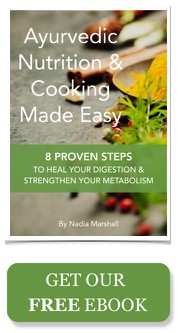By Nadia Marshall
What is Turmeric?
Turmeric comes from the root of the Turmeric Plant (Curcuma Longa), part of the ginger family. So in its fresh form it looks a lot like ginger. You can buy it fresh in some Asian grocers but mostly you buy it as a dried, ground powder that has an amazing orange colour. It is native to tropical South Asia, grows in temperatures between 20-30 degrees C and needs considerable rainfall to do well. But anyone living in Northern NSW can grow it with ease....
Turmeric is an ancient spice that has been used medicinally and in religious rituals in India and China as long ago as the 7th century BC. In medieval Europe, it became known as Indian saffron because it was cheaper and more readily available than actual saffron.
What are its qualities?
From an Ayurvedic perspective, turmeric has the following qualities...
Rasa: Pungent, Bitter, Astringent
Virya: Warming
Vipaka: Pungent
Qualities: Light, Dry, Digestive
Actions on the doshas: Tridoshic, balances Vata, Pitta and Kapha
Action on the mind: Sattvic
Fresh turmeric is more pungent and has a much stronger flavour than the ground powder. But generally, due to its intense colour and strong bitterness, you only use small amounts of turmeric in your cooking.
What are its medicinal qualities?
If you've been reading any health-related magazines or websites lately, you'll know that Turmeric is an emerging superfood! From an Ayurvedic perspective, Turmeric is believed to be anti-fungal, anti-bacterial, anti-inflammatory, anti-aging and anti-carcinogenic. It is excellent for digestion, helping to reduce gas, bloating, cramping and colic and aids the digestion of protein. It reduces the production and accumulation of ama (or toxins) and pathogenic bacteria in the gut, and decreasing the risk of bowel cancer. It is also useful in the treatment of diabetes, liver diseases and eye problems. Due to its anti-inflammatory properties, it is used in the treatment of a variety of skin problems, arthritis, joint inflammation and gut inflammation (e.g. gastritis, ulcers, ulcerative colitis, Crohn's). It protects against heart disease; cleansing the blood, reducing cholesterol, scraping unwanted accumulations from the blood vessel walls and nourishing to the heart. Turmeric promotes the flow of menses in the case of menstrual disorders, purifies breast milk and can be used as a poultice in the case of mastitis. It is also anti-biotic and brilliant for wound healing both internally and externally. If you cut yourself, apply turmeric to the wound and it will heal at least twice as fast! Turmeric is also used cosmetically - improving skin pigmentation, skin tone and controlling hair growth. Due to its sattvic quality, it also promotes a calm mind. A superfood indeed!!
The Western viewpoint.
Research into the benefits of turmeric has taken off over the past few years and the results support what traditional medicine has known for thousands of years. It is being looked into for possible benefits in Alzheimer's, dementia, cancer (especially bowel cancer), arthritis, lung injury and a variety of other clinical disorders. Research suggests it is also useful in the treatment of indigestion, ulcerative colitis, stomach ulcers, osteoarthritis, heart disease, bacterial and viral infections and uveitis (an eye-inflammation disease). And it has been confirmed that it is a super super anti-oxidant!
How do you eat it?
We have turmeric with almost everything we cook - kicharee, soups, daals, curries, casseroles, vegetable subjis, vegetable patties, even savoury pancakes. We often have some with a warm milk in the evenings too. We even use turmeric in the dogerees (or casseroles) we make for the dogs - to help protect them against bowel cancer and arthritis! When cooking with turmeric, it is quite a delicate spice in its powdered form so you don't even have to fry it off - you can just add it to water during the cooking process. If you do fry it off, make sure it is one of the last spices you add to the pot so you don't overcook it (which may increase its bitterness).
Why do I love it?
I particularly love the colour of turmeric as well as the subtle 'curry' flavour. Most dishes just don't seem right until you add a little turmeric - they look bland. I also love knowing that it is so incredibly good for me... that every day I am taking an accumulative medicine that is helping my digestion, my liver, my blood, my heart, my skin, even my eyes.
Should anyone avoid eating it?
Everyone will benefit from eating turmeric every single day. It should not be an occasional spice... it should be a daily one, especially if you eat meat. However, if you are pregnant, you may want to just eat a little each day rather than a lot and avoid taking any turmeric supplements (its action of stimulating menstrual flow is something you want to avoid, especially in early pregnancy - but a little in your food as a spice is perfectly safe).
Where do you get it from?
It is very readily available. If getting it from supermarkets, buy it in the little green bags rather than the jars as the bags tend to have more flavour. But..... if you get into turmeric as much as you should, you're going to need bigger bags! You can buy it in bulk either from healthfood stores or Asian Grocers. We buy our organic ground turmeric in 1kg jars from www.herbsupplies.com.au.
Tell me about your experience with turmeric... and why you love it! xx
Love
Nadia x

AYURVEDIC TERMINOLOGY
Agni - the digestive fire.
Ama or Aama - undigested food waste, toxins.
Ojas- the foundation of our immune system and longevity.
Dhatus - the tissues of the body.
Srotas - the channels of the body.
Vata - the air/ether
intelligence in the body.
Pitta- the fire/water
intelligence in the body.
Kapha- the water/earth intelligence in the body.
Sattva- the quality of purity, intelligence, peace and love.
Rajas- the quality of
turbulence and activity.
Tamas- the quality of
dullness, darkness and inertia.
Rasa - the taste of a food (Sweet, Sour, Salty, Pungent, Bitter, Astringent)
Virya - second level of digestion (either Heating or Cooling)
Vipaka - third level of digestion, the deep taste of a food (can be Sweet, Sour or Pungent)
Prabhav - the 'special effect' of a food or herb/spice
Rasa - also the name for plasma tissue
Rakta - blood tissue
Mamsa - muscle tissue
Meda - fat tissue
Asthi - bone tissue
Majja - nerve & bone marrow tissue
Shukra - sexual reproductive tissue


